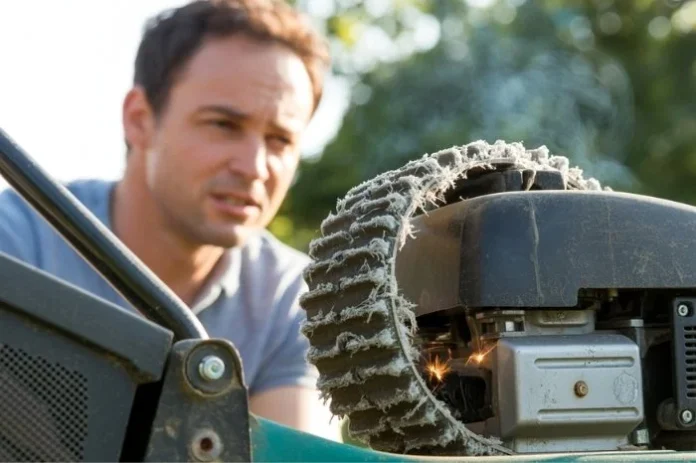A lawnmower is a vital tool for maintaining a beautiful and well-maintained lawn. However, like all mechanical equipment, it requires regular maintenance to keep running smoothly. One component that often gets overlooked until it causes problems is the lawnmower drive belt.
This critical part transmits power from the engine to the blades and wheels, and when it wears out, it can cause a range of issues that affect your mower’s performance.
In this article, we will examine the common problems associated with a worn-out lawnmower drive belt and why maintaining this component in good condition is crucial.
Top 6 Common problems associated with a worn-out lawnmower drive belt
1. Reduced Cutting Efficiency
One of the most noticeable problems caused by a worn lawnmower drive belt is a decline in cutting performance. The belt is responsible for spinning the blades at the proper speed to ensure a clean, even cut. When the belt becomes stretched, cracked, or frayed, it may slip or fail to transfer power efficiently. As a result, you might notice uneven grass heights, patchy cutting, or missed spots.
A slipping belt often causes the blades to slow down or stop intermittently, which directly impacts the quality of your mowing job. This problem can be especially frustrating when you spend time mowing, only to find that the grass still looks untidy. Keeping the belt in good shape is key to maintaining a consistently healthy-looking lawn.
2. Mower Won’t Move or Self-Propel Issues
Many modern lawnmowers feature self-propelling capabilities, which rely heavily on the drive belt. When the belt wears out or breaks, the mower may lose its ability to move forward independently. This means you’ll have to push it manually, making the task more labor-intensive.
A worn belt can slip on the pulleys, causing inconsistent movement or a complete loss of propulsion. In some cases, the mower may jerk or hesitate while moving, indicating that the belt is struggling to maintain traction.
If you experience these symptoms, it’s a clear indication that the lawnmower drive belt needs attention or replacement.
3. Unusual Noises During Operation
Another common issue associated with a worn drive belt is the appearance of unusual noises when starting or operating your mower. These sounds may include squealing, chirping, or grinding, which often signal belt slippage or misalignment.
Squealing noises usually occur when the belt slips on the pulleys due to loss of tension or surface wear. If you hear such sounds regularly during mowing, it’s wise to inspect the belt for cracks, glazing, or damage. Ignoring these noises can lead to sudden belt failure, resulting in unexpected downtime and repair expenses.
4. Overheating and Engine Strain
A failing drive belt can also put extra stress on your mower’s engine. When the belt slips or doesn’t turn the blades smoothly, the engine has to work harder to compensate. This additional workload can cause the engine to overheat, especially during prolonged mowing sessions or in hot weather.
Engine strain not only affects performance but can also reduce the lifespan of your mower. If you notice your mower overheating or running louder than usual, it’s worth checking the condition of the lawnmower drive belt. Timely belt maintenance helps keep the engine running efficiently and prevents costly engine repairs.
5. Damage to Other Components
When a lawnmower drive belt is worn or damaged, it doesn’t just affect itself—it can cause a domino effect on other parts of your mower. A slipping or broken belt can lead to excessive wear on pulleys, bearings, and spindles. This added stress can cause these components to fail prematurely, increasing maintenance costs.
For example, if the belt frequently slips, it can cause the pulleys to spin unevenly or wobble, leading to bearing wear or misalignment. This kind of damage may require more extensive repairs than simply replacing the belt. By maintaining your drive belt regularly, you protect not only the belt itself but also the other vital parts of your mower.
6. Difficulty Starting the Mower
In some cases, a worn or loose drive belt can make it harder to start your lawnmower. Since the belt is connected to essential systems, such as the blades and self-propulsion, a belt that isn’t functioning properly may cause resistance when starting the engine.
You might notice that your mower’s engine struggles to engage or rev up when the belt is worn. This problem is less common than others, but it can still occur, indicating that the belt is not transferring power effectively. Addressing belt issues promptly can help prevent start-up problems and ensure smoother operation.
Conclusion
A worn lawnmower drive belt can cause a variety of problems—from poor cutting performance and loss of propulsion to unusual noises and increased engine strain. Because the belt plays such a critical role in your mower’s operation, neglecting its maintenance can lead to costly repairs and frustrating downtime.
Regular inspection and timely replacement of your lawnmower drive belt are essential to keeping your mower running efficiently. By paying attention to signs of wear and addressing issues promptly, you can prolong the life of your equipment and maintain a consistently well-maintained lawn.





